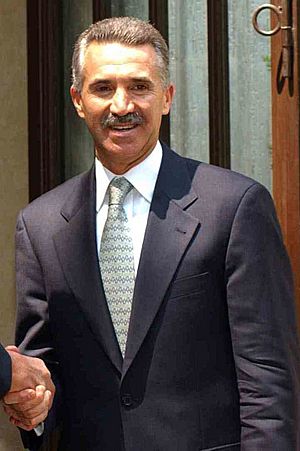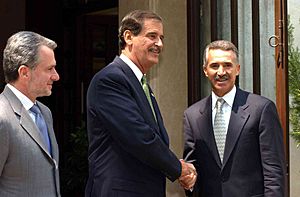Roberto Madrazo facts for kids
Quick facts for kids
Roberto Madrazo
|
|
|---|---|

Madrazo in 2004
|
|
| Governor of Tabasco | |
| In office January 1, 1995 – December 31, 2000 |
|
| Preceded by | Víctor Manuel Barceló |
| Succeeded by | Enrique Priego Oropeza |
| Deputy of the Congress of the Union for Tabasco's 1st district |
|
| In office 1991–1994 |
|
| Deputy of the Congress of the Union for Tabasco's 2nd district |
|
| In office September 1, 1976 – August 31, 1979 |
|
| Preceded by | Humberto Hernández Haddad |
| Succeeded by | Ángel Mario Martínez Zentella |
| Personal details | |
| Born |
Roberto Madrazo Pintado
July 30, 1952 Villahermosa, Tabasco, Mexico |
| Political party | Institutional Revolutionary Party |
| Spouse |
Isabel de la Parra
(m. 1982) |
| Education | National Autonomous University of Mexico University of California at Los Angeles |
Roberto Madrazo Pintado, born on July 30, 1952, is a politician from Mexico. He is a member of a political group called the Institutional Revolutionary Party (PRI). He ran for president of Mexico in 2006. Before that, he was the Governor of the state of Tabasco from 1995 to 2000.
Contents
Early Life and Education
Roberto Madrazo was born in Villahermosa, a city in the state of Tabasco, Mexico. His parents were Carlos A. Madrazo and Graciela Pintado Jiménez. His father was also a politician who wanted to make changes.
When Roberto was sixteen, both of his parents died in a plane crash. Even though his father came from a simple background, his good reputation helped Roberto become part of Mexico's important families. Roberto studied law at the National Autonomous University of Mexico in Mexico City. He also studied urban planning at the University of California at Los Angeles (UCLA).
Starting His Political Career
Roberto Madrazo began his political journey by representing his home state of Tabasco. Between 1976 and 1988, he served in both the Chamber of Deputies and the Senate. These are parts of Mexico's national government.
Later, he became the Governor of Tabasco, serving from 1994 to 2000. As governor, he was known for being a "populist" politician. This means he tried to appeal to ordinary people and often supported policies that aimed to help the economy grow.
Running for President in 2000
In 2000, Roberto Madrazo wanted to become the presidential candidate for his party, the PRI. However, he lost to Francisco Labastida. In Mexico, it was a tradition for the current president to choose who would run next, a practice sometimes called dedazo (meaning "the finger"). Madrazo was against this tradition.
He even used a clever slogan: "Dale un Madrazo al dedazo!" This phrase played on his last name, "Madrazo," which can also mean a strong hit in Mexican Spanish. He wanted to "hit" or end the old way of choosing candidates. Even though he gained some supporters, the party's primary election, which was open to all registered voters, chose Labastida.
Madrazo accepted the results. However, his strong campaign against the old system made Labastida's chances weaker in the eyes of voters. Many people believe this was a big reason why the PRI lost the presidential election for the first time ever in 2000. The winner was Vicente Fox Quesada from the National Action Party (PAN).
Leading the PRI Party
After the PRI lost the presidency in 2000, the party faced a difficult time. Roberto Madrazo is often given credit for helping the party stay together. He worked to unite different groups within the PRI and managed to calm down political disagreements.
In 2002, Madrazo ran to become the leader of the PRI party. He teamed up with Elba Esther Gordillo, a powerful leader of a teachers' union. Together, they won the election against their opponent, Senator Beatriz Paredes. After this, Gordillo and Madrazo became political rivals.

The 2006 Presidential Campaign
As the leader of the PRI, Madrazo had a good chance to become the party's candidate for the 2006 presidential election. Other politicians in the PRI wanted to run too. Some state governors formed a group called Democratic Unity, which was nicknamed TUCOM (Todos Unidos Contra Madrazo, meaning "All United Against Madrazo"). They chose Arturo Montiel as their candidate.
In the primary elections, Madrazo, Montiel, and another candidate competed. Montiel later stepped down due to some legal issues. This meant Madrazo became the PRI's candidate. He then formed an alliance with the Ecologist Green Party of Mexico (PVEM).
Madrazo faced two main opponents in the election: Andrés Manuel López Obrador from the PRD party, and Felipe Calderón from the PAN party. López Obrador had previously run against Madrazo for the Tabasco governorship in 1994.
Elba Esther Gordillo, Madrazo's former ally, created a new political party called Partido Nueva Alianza to oppose him in the presidential race. She believed Madrazo was not the right person to be president.
Before the election, polls showed Madrazo had about 30 percent support. On July 3, 2006, Madrazo and his party accepted their defeat in the presidential election. He received 22.26% of the votes, which was the PRI's lowest result for a presidential election at that time.
Marathon Controversy
In 2007, Roberto Madrazo was involved in a controversy during the Berlin Marathon. He was accused of not completing the entire race course. His times at certain checkpoints were not recorded. He was later disqualified from the race.
Personal Life
Roberto Madrazo is married to Isabel de la Parra Trillo.
See also
 In Spanish: Roberto Madrazo Pintado para niños
In Spanish: Roberto Madrazo Pintado para niños

